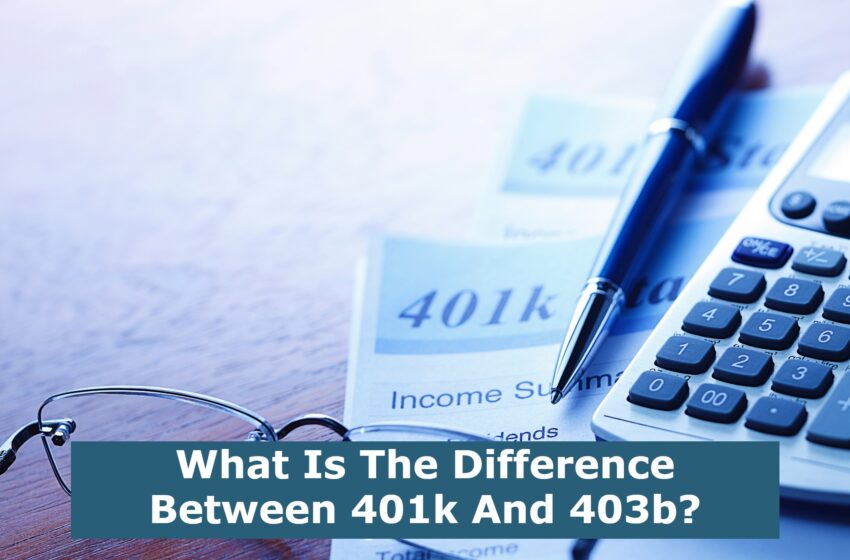
What Is The Difference Between 401k And 403b?
You might be wondering what the differences are between a 401k and a 403b. The good news is that they are similar to each other in many ways, but there are some significant differences. If you are looking to open a new retirement account, it’s a good idea to learn the ins and outs of these two types of plans.
Tax-deferred growth
When an employee chooses to participate in a 401k or 403b plan, they may benefit from tax-deferred growth on their earnings. The tax advantages of these plans can be particularly beneficial to older employees. However, it is important to understand the limits of both plans. In addition to the contribution limit, it is also crucial to consider the investment options and the employer’s match.
Although the total dollar amount of contributions to a 401k plan has increased over time, the percentage of workers contributing the maximum has decreased. This decrease has been accompanied by a rise in the share of large contributors.
Workers who are over 50 are more likely to contribute the maximum. Additionally, more young workers have a lot of their wealth in their employer’s savings plan. These changes suggest that the full tax preference may be reduced in the future.
Both plans are regulated by the IRS, which controls the maximum contribution limits. Employees can choose to make contributions on a pre-tax or post-tax basis. Pre-tax contributions are tax-deductible, while post-tax contributions are not.
Investment options
Retirement plans are an important part of building a secure financial future. You can invest in a variety of retirement vehicles, including IRAs and 401(k) plans. A 401(k) plan is an employer-sponsored retirement savings plan that allows employees to make pre-tax contributions. It can be funded with a mixture of securities and may include company stock.
Generally, the annual contribution limits for 401(k) and 403(b) plans are $20,500 for 401(k)s and $27,000 for 403(b)s in 2022. Some employers match employee contributions, such as dollar for dollar, or on a percentage basis. However, some employers also make discretionary contributions, which may not have the same effect on a participant’s ability to make contributions.
Both plans offer the ability to contribute to a retirement account, but 401(k) plans typically have more investment choices. Typical investments include stocks, bonds, and mutual funds. In addition, 401(k) accounts are automatically covered by the Employee Retirement Income Security Act.
Nondiscrimination testing
If your employer offers a retirement plan, your plan must pass annual nondiscrimination tests. This ensures that your plan is not biased toward certain types of employees. Specifically, your plan must have a nondiscriminatory method of allocating contributions.
The most common way of allocating employer contributions is proportional to the pay of a particular employee. Plan sponsors may use different allocation methods, however. Some methods can be complicated, while others can be beneficial for some employees.
Nondiscrimination testing typically occurs in the fourth quarter of the plan year. In order to avoid tax penalties for failure, your plan must provide testing results. Failure to do so may have unwelcome consequences for your employees.
As part of your testing, you will need to determine the average amount of contributions that employees are deferring. These contributions are compared to the contributions that other employees are deferring. During the test, you can also compare the amount of money that employees receive as a match.
Cost
401(k) and 403(b) plans are employer-sponsored retirement savings plans that allow employees to save for their future. 401(k) plans are often sponsored by for-profit companies, while 403(b) plans are typically administered by nonprofit organizations, governmental entities, or schools. In both cases, costs vary widely, depending on the type of plan and the provider. For example, the annual cost of a 401(k) plan can range from 0.5 percent to 3.0 percent of assets, while the same plan for a 403(b) can be anywhere from 0.4 percent to 1.4 percent.
Generally speaking, a 401(k) plan offers a wider variety of investment options. Some plan providers offer index funds, which have a low expense ratio, while other plans may only have a few fund offerings. Regardless of which type of plan you choose, it’s important to make sure you know what your plan offers.
One major difference between a 401(k) and a 403(b) plan is the treatment of early distributions and rollovers. A 403(b) is not subject to the stricter federal rules that a 401(k) is. It is also not subject to any consumer protections.


